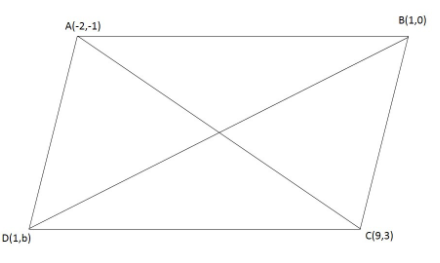
If the points $\text{A(-2,-1)}\,\text{,}\,\text{B(1,0)}\,\text{,}\,\text{1(a,3)}\,\text{and}\,\text{D(1,b)}$ from a parallelogram ABCD , find the value of a and b .
Answer
574.2k+ views
Hint: In the question, we have been given the four vertices of a parallelogram. First, we draw a rough sketch and you can see the midpoints of AC and BD coincide. so we use the property of parallelogram that diagonals bisect each other and with the distance two points formula, we can solve the question.
Complete step by step solution:

Now, as we can see the diagonals of the parallelogram bisect each other.
This means that the mid – point of the diagonal AC coincide with the mid point of the diagonal BD .
$\therefore $ Midpoint of formula for two points
\[\begin{align}
& \text{(}{{\text{x}}_{\text{1}}}\,\text{,}\,{{\text{y}}_{\text{1}}}\text{)}\,\text{ }\!\!\And\!\!\text{ }\,\text{(}{{\text{x}}_{\text{2}}}\,\text{,}\,{{\text{y}}_{\text{2}}}\text{)}\,\text{is} \\
& \text{(x}\,\text{,}\,\text{y)}\,\text{=}\,\left( \dfrac{{{\text{x}}_{\text{1}}}\,\text{+}\,{{\text{x}}_{\text{2}}}}{\text{2}}\,\text{,}\,\dfrac{{{\text{y}}_{\text{1}}}\,\text{+}\,{{\text{y}}_{\text{2}}}}{\text{2}} \right) \\
& \text{=}\,\left( \dfrac{\text{a-2}}{\text{2}}\,\text{,}\,\text{1} \right) \\
& \text{Now}\,\text{,}\,\text{mid-point}\,\text{of}\,\text{BD}\,\text{=}\,\left( \dfrac{\text{1+1}}{\text{2}}\,\text{+}\,\dfrac{\text{b+0}}{\text{2}} \right) \\
& \text{=}\,\left( \dfrac{\text{2}}{\text{2}}\,\text{,}\,\dfrac{\text{b}}{\text{2}} \right) \\
& \text{=}\,\left( \text{1}\,\text{,}\dfrac{{}}{\text{2}} \right)\text{.}
\end{align}\]
Now , as we know ,
Midpoint of AC = midpoint of BD
\[\dfrac{\text{a-2}}{\text{2}}\,\text{=}\,\text{1}\,\text{and}\,\text{1}\,\text{=}\dfrac{\text{b}}{\text{2}}\]
Solving the above equation ,
\[\begin{align}
& \text{a -2}\,\text{=}\,\text{2}\,\text{and}\,\text{2}\,\text{=}\,\text{b} \\
& \text{a}\,\text{=}\,\text{2+2} \\
& \text{a}\,\text{=}\,\text{4}\,\text{and}\,\text{b}\,\text{=2} \\
&
\end{align}\]
Hence ,$\text{a}\,\text{=}\,\text{4}\,\text{and}\,\text{b=}\,\text{2}$
Note: Basic important properties of parallelogram are :
(1) opposite sides are congruent.
(2) opposite angles are congruent.
(3) consecutive angles are supplementary.
(4) If one angle is right, then all angles are right
(5) Diagonals bisect each other.
Complete step by step solution:

Now, as we can see the diagonals of the parallelogram bisect each other.
This means that the mid – point of the diagonal AC coincide with the mid point of the diagonal BD .
$\therefore $ Midpoint of formula for two points
\[\begin{align}
& \text{(}{{\text{x}}_{\text{1}}}\,\text{,}\,{{\text{y}}_{\text{1}}}\text{)}\,\text{ }\!\!\And\!\!\text{ }\,\text{(}{{\text{x}}_{\text{2}}}\,\text{,}\,{{\text{y}}_{\text{2}}}\text{)}\,\text{is} \\
& \text{(x}\,\text{,}\,\text{y)}\,\text{=}\,\left( \dfrac{{{\text{x}}_{\text{1}}}\,\text{+}\,{{\text{x}}_{\text{2}}}}{\text{2}}\,\text{,}\,\dfrac{{{\text{y}}_{\text{1}}}\,\text{+}\,{{\text{y}}_{\text{2}}}}{\text{2}} \right) \\
& \text{=}\,\left( \dfrac{\text{a-2}}{\text{2}}\,\text{,}\,\text{1} \right) \\
& \text{Now}\,\text{,}\,\text{mid-point}\,\text{of}\,\text{BD}\,\text{=}\,\left( \dfrac{\text{1+1}}{\text{2}}\,\text{+}\,\dfrac{\text{b+0}}{\text{2}} \right) \\
& \text{=}\,\left( \dfrac{\text{2}}{\text{2}}\,\text{,}\,\dfrac{\text{b}}{\text{2}} \right) \\
& \text{=}\,\left( \text{1}\,\text{,}\dfrac{{}}{\text{2}} \right)\text{.}
\end{align}\]
Now , as we know ,
Midpoint of AC = midpoint of BD
\[\dfrac{\text{a-2}}{\text{2}}\,\text{=}\,\text{1}\,\text{and}\,\text{1}\,\text{=}\dfrac{\text{b}}{\text{2}}\]
Solving the above equation ,
\[\begin{align}
& \text{a -2}\,\text{=}\,\text{2}\,\text{and}\,\text{2}\,\text{=}\,\text{b} \\
& \text{a}\,\text{=}\,\text{2+2} \\
& \text{a}\,\text{=}\,\text{4}\,\text{and}\,\text{b}\,\text{=2} \\
&
\end{align}\]
Hence ,$\text{a}\,\text{=}\,\text{4}\,\text{and}\,\text{b=}\,\text{2}$
Note: Basic important properties of parallelogram are :
(1) opposite sides are congruent.
(2) opposite angles are congruent.
(3) consecutive angles are supplementary.
(4) If one angle is right, then all angles are right
(5) Diagonals bisect each other.
Recently Updated Pages
Master Class 9 General Knowledge: Engaging Questions & Answers for Success

Master Class 9 English: Engaging Questions & Answers for Success

Master Class 9 Science: Engaging Questions & Answers for Success

Class 9 Question and Answer - Your Ultimate Solutions Guide

Master Class 12 Economics: Engaging Questions & Answers for Success

Master Class 12 Maths: Engaging Questions & Answers for Success

Trending doubts
Which places in India experience sunrise first and class 9 social science CBSE

Fill the blanks with the suitable prepositions 1 The class 9 english CBSE

Write the 6 fundamental rights of India and explain in detail

Difference Between Plant Cell and Animal Cell

What is pollution? How many types of pollution? Define it

What is the Full Form of ISI and RAW




